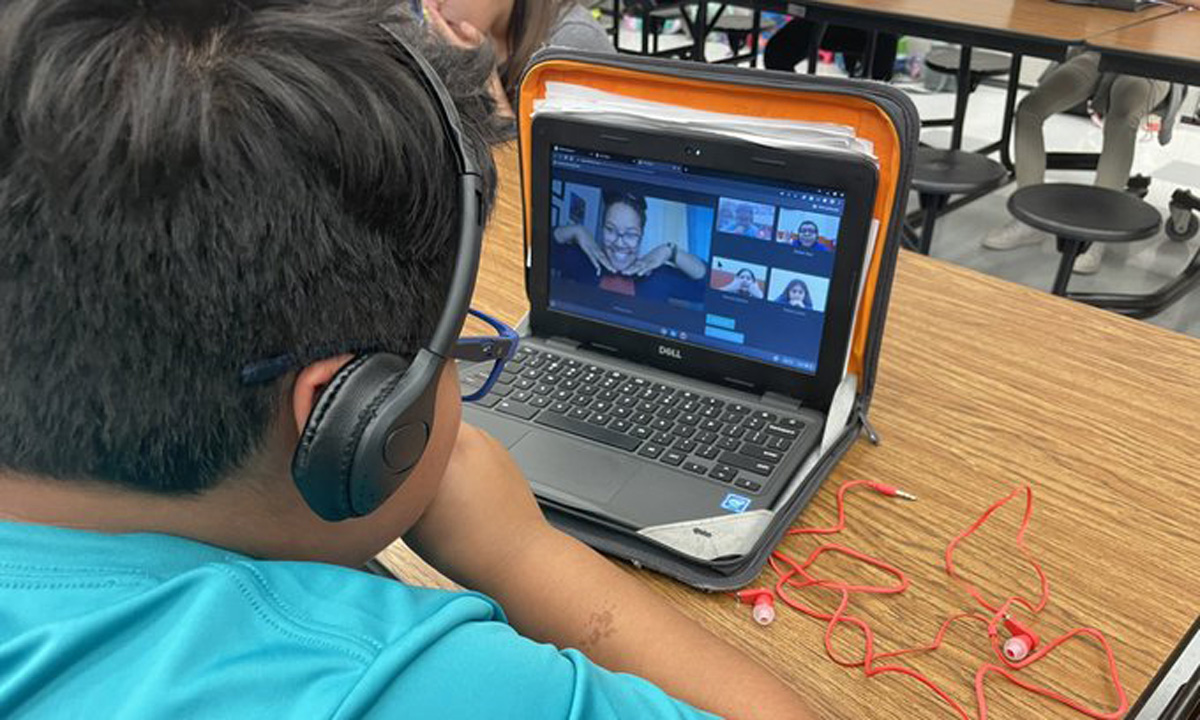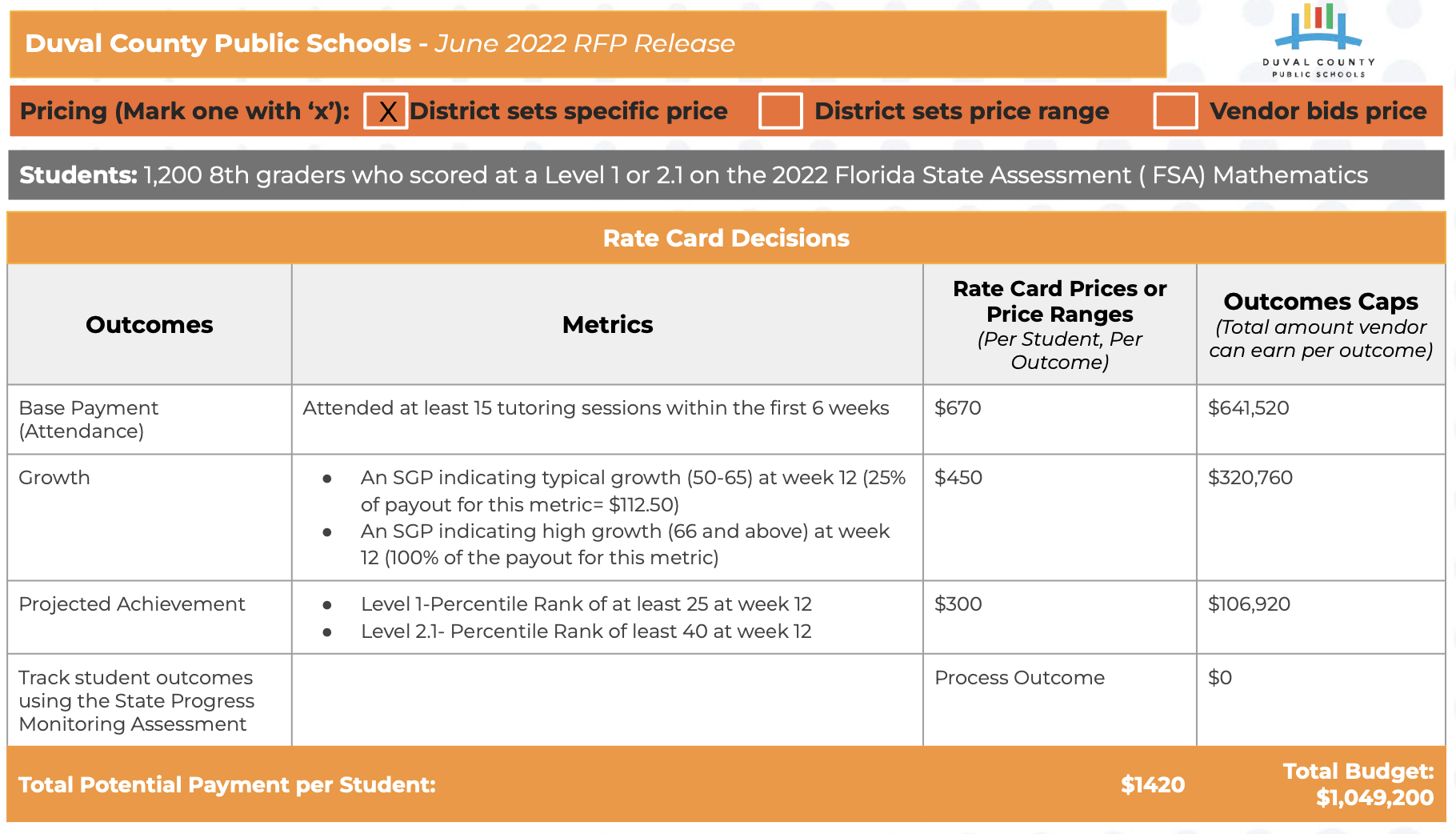Tutoring’s New Game: Better Academic Results Yield Bigger Payoffs for Providers
In linking pay to student progress, participants in ‘outcomes-based’ efforts say accountability must be a ‘two-way street.’

Get stories like this delivered straight to your inbox. Sign up for The 74 Newsletter
Last fall, Florida’s Duval County Schools pegged 450 eighth graders who were off-track for high school algebra to take part in an ambitious new tutoring effort.
The results caused a stir among principals. By the end of April, nearly half the students did well enough on tests to skip a second year in lower-level math.
“Some of the schools we targeted typically don’t see high performance,” said Jasmine Milner, the director of K-12 math in the district, which includes Jacksonville.
That’s what the district hoped when it entered into what is known as an outcomes-based contract with FEV Tutor, which provides virtual, one-on-one sessions during the school day. The company stood to make more money for better results — as much as $750 per student more, over a base of $670, depending on the amount of progress. Proponents of the model, more common in the health care and energy industries, say it increases accountability for both providers and school districts.
“It ups the stakes for everybody to really pay attention to the data,” said Brittany Miller, who leads a 10-district outcomes-based initiative at Southern Education Foundation, a nonprofit focused on equity.
With research showing that far fewer students took advantage of online tutoring than districts expected, the outcomes-based model is one way to ensure districts use public funds wisely. “In education, we can pay for things a long time before we realize no children are participating in it,” Miller said.
Facing overwhelming declines in achievement as a result of remote learning and growing pressure to show a high return on federal relief funds, more districts are taking an interest in such transactions.
Because of relief funds, districts have “been able to make investments in public education like we’ve never been able to do before,” said Scott Muri, superintendent of the Ector County Independent School District in west Texas. “I could have done a small pilot, but even coming up with a million [dollars] to do the [tutoring] work would have been incredibly challenging.”
The Ector district spent $10 million in relief funds on three years of virtual tutoring, most of it going to contracts with two leading tutoring companies, FEV and Air Tutors.
But first, there was some matchmaking to do.
The district whittled down a list of 11 companies to five and set up what Lilia Nanez, the district’s associate superintendent of curriculum and instruction, called “speed dating” sessions with school principals.
FEV and Air Tutors “hit the mark because they had clear objectives for vetting and training,” Nanez said during a May conference on high-dosage tutoring at Stanford University.
Like Duval, Ector was among the original four districts in the Southern Education Foundation’s project in 2022. The network has grown to 10 districts, but Miller said any district can use the organization’s resources, such as its template for contracts.
Since the 2021-22 school year, over 10,000 Ector students have received tutoring.
Itzel Espinoza credits the program with helping her graduate on time. Texas students must pass three of five end-of-course exams to earn a diploma, but she kept failing the Algebra I assessment.

She struggled with graphing and knowing which variables to enter into her calculator. She failed four times before the district matched her with John Villamor, an Air tutor. He found that Itzel lacked some basic understanding of fractions and order of operations.
After meeting virtually twice a week, sometimes for more than an hour, the equations began to make sense. “He just knows how to explain it,” she said. By the fifth try, she said, the test was easy. “I knew I was going to pass.”
Providers say the financial incentive to boost student performance helps them prove their value to district leaders.
Outcomes-based contracting is “a great way to get a footing into a district and make sure that the promises a provider tells in their pitch are actual deliverables,” said Hasan Ali, founder and CEO of Air Tutors.

In return, he said, districts have to “dedicate energy” to develop the contract, schedule tutoring sessions and follow up with students who don’t participate.
Not ‘the only way’
One drawback of such arrangements, however, is that they don’t allow much wiggle room if a provider needs to add students, sessions or any other specifics not nailed down in the contract.
The model marks a significant shift from how districts have traditionally approached academic interventions, said tutoring experts. Officials who review bids from outside contractors don’t typically sit at the table with a district’s academic team.
Some leaders might find it too daunting to get staff from different departments to work together and could give up on tutoring efforts completely, said Kathy Bendheim, managing director of the National Student Support Accelerator, which researches high-dosage tutoring and organized the Stanford conference.
“What I don’t want is people to think [outcomes-based contracting is] the only way to do it,” she said.
On the flip side, a superintendent could say, “Let’s re-do all our contracts this way,” said Liz Cohen, policy director at FutureEd, a Georgetown University think tank. She’s currently researching three tutoring efforts, including one in a district using outcomes-based tutoring.
Overall, she thinks the increased attention to contracts with outside vendors is healthy. She called districts’ business deals the “least sexy and probably the most impactful way that this sausage gets made.”
A focus on attendance
In education, the practice is still relatively new, but many providers are following it with interest.
Kate Bauer-Jones leads Future Forward, which provides in-school tutoring for struggling readers in seven states. But many of the districts using the program are in rural areas, and she doubts they have educators with the time and expertise to manage and analyze the data in the way such contracts require.
“There are superintendents who are also running the transportation department,” she said.
Districts using the approach spend a lot of time up front discussing the outcomes they want, which students they’ll target and what assessments to use to measure progress.
Providers also want to know how their bottom line would be affected if students don’t show up.
Jessica Sliwerski, co-founder and CEO of Ignite! Reading, which provides in-school virtual tutoring, said her team works hard to recruit and train tutors and has literacy specialists who meet monthly with district leaders.
“What we cannot control is student attendance,” she said. “The attendance issues post-COVID in economically depressed areas are worse than they were prior to the pandemic. This is a significant and real pain point for schools.”
While data from 2021-22 is not yet available, rates of chronic absenteeism doubled in several states during the 2020-21 school year. And research on pandemic recovery shows that even when students go to school, they might not participate in optional before or afterschool tutoring because of their parents’ schedules or lack of transportation.
To address those concerns, some districts — including the Denver Public Schools, Colorado Springs District 11 and the Uplift charter network in Texas — have included clauses in their contracts stating that if a student’s attendance in tutoring falls below 70%, the district still has to pay the provider the highest rate.
Knowing when students are more likely to participate — and what incentives they’ll respond to — is part of making the arrangement work. Muri said he learned not to schedule tutoring for older students before the school day because they weren’t likely to get up any earlier for it. And some schools in Duval County purchased snow-cone and popcorn machines as an added bonus for students.
But Sliwerski said before she’d consider such a contract, she’d want to know how districts are communicating with families about the importance of coming to school every day.
The data from schools offering Ignite! Reading shows that 75% student attendance at tutoring sessions is necessary for “incredible results,” she said. “Accountability doesn’t scare me; I love accountability as long as it’s a two-way street.”
Get stories like these delivered straight to your inbox. Sign up for The 74 Newsletter

;)
